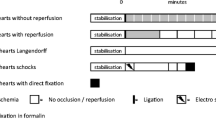Abstract
The verification of acute and lethal myocardial infarctions remains a crucial problem in the daily routine work of legal medicine. In order to enhance the possibilities in micromorphologic diagnostics, we investigated if dityrosine as a protein product of oxidative stress can be detected in myocardial tissue after an infarction and, if so, if it occurs early enough to be used in the diagnosis of infarctions with a short survival time. We examined tissue samples from 61 autopsy cases (37 male, 24 female) with verified or suspected infarctions as well as 11 control cases (7 male, 4 female). Immunohistochemical staining was performed for dityrosine and the established markers fibronectin and C5b-9. Positive staining for dityrosine was obtained in nearly all cases with infarctions aged 4 h to 2 weeks. Single positive results were obtained in cases with older (up to 2 months) or assumedly very fresh (up to 4 h) infarctions. Furthermore, single positive results with a different staining pattern were obtained in the control group. We concluded that dityrosine as a marker of oxidative stress can be detected after infarctions and might occur early enough to be helpful in the diagnosis of infarctions with a short survival time. Though dityrosine does not seem to be specific for infarctions, the different staining patterns enable a differentiation.


Similar content being viewed by others
References
Bolli R, Marban E (1999) Molecular and cellular mechanisms of myocardial stunning. Physiol Rev 79:609–634
Carden DL, Granger DN (2000) Pathophysiology of ischaemia-reperfusion injury. J Pathol 190:255–266
Cummings PM, Trelka DP, Springer KM (2011) Atlas of forensic histopathology. Cambridge University Press, Cambridge
Davies MJ (2005) The oxidative environment and protein damage. Biochem Biophys Acta 1703:93–109
Edson E (1997) Evaluation of agonal artifacts in the myocardium using a combination of histological stains and immunohistochemistry. Am J Forensic Med Pathol 18:163–167
Fracasco T, Pfeiffer H, Michaud K, Köhler H, Sauerland C, Schmeling A (2011) Immunohistochemical expression of fibronectin and C5b-9 in cases of carbon monoxide poisoning. Int J Legal Med 125:377–384
Giulivi C, Traaseth NJ, Davies KJA (2003) Tyrosine oxidation products: analysis and biological relevance. Amino Acids 25:227–232
Halliwell B, Gutteridge JMC (2007) Free radicals in biology and medicine. Oxford University Press, New York
Hu B-J, Chen Y-C, Zhu J-Z (1996) Immunohistochemical study of fibronectin for postmortem diagnosis of early myocardial infarction. Sci Int 78:209–217
Lesnefsky EJ, Moghaddas S, Tandler B, Kerner J, Hoppel CL (2001) Mitochondrial dysfunction in cardiac disease: ischemia-reperfusion, aging and heart failure. J Mol Call Cardiol 33:1065–1089
Ortmann C, Pfeiffer H, Brinkmann B (2001) Immunohistochemical alterations after intravital and post-mortem traumatic myocardial damage. Int J Legal Med 115:23–28
Ortmann C, Pfeiffer H, Brinkmann B (2000) A comparative study on the immunohistochemical detection of early myocardial damage. Int J Legal Med 113:215–220
Schäfer H, Mathey D, Hugo F, Bhakdi S (1986) Deposition of the terminal C5b-9 complement complex in infarcted areas of human myocardium. J Immunol 137:1945–1949
Solaini G, Harris DA (2005) Biochemical dysfunction in heart mitochondria exposed to ischaemia and reperfusion. Biochem J 390:377–394
Thomsen H, Held H (1995) Immunohistochemical detection of C5b-9(m) in myocardium; an aid in distinguishing infarction-induced heart muscle necrosis from other forms of lethal myocardial injury. Sci Int 71:87–95
Thomsen H, Schulz A, Bhakadi S (1990) Immunhistochemische C5b-9-Komplement-Komplex-Darstellung in Frühstadien der Herzmuskelnekrose im Paraffinschnitt. Z Rechtsmed 103:199–206
Van Dijk A, Niessen HWM, Ursem W, Twisk JWR, Visser FC, van Milligen FJ (2008) Accumulation of fibronectin in the heart after myocardial infarction: a putative stimulator of adhesion and proliferation of adipose-derived stem cells. Cell Tissue Res 332:289–298
Willems IEMG, Arends J-W, Daemen MJAP (1996) Tenascin and fibronectin expression in healing human myocardial scars. J Pathol 179:321–325
Author information
Authors and Affiliations
Corresponding author
Rights and permissions
About this article
Cite this article
Mayer, F., Pröpper, S. & Ritz-Timme, S. Dityrosine, a protein product of oxidative stress, as a possible marker of acute myocardial infarctions. Int J Legal Med 128, 787–794 (2014). https://doi.org/10.1007/s00414-014-1015-z
Received:
Accepted:
Published:
Issue Date:
DOI: https://doi.org/10.1007/s00414-014-1015-z




